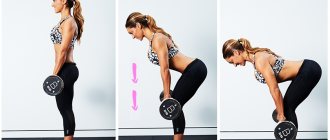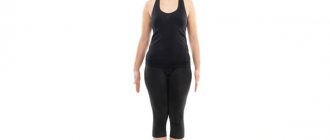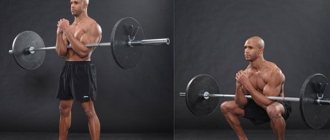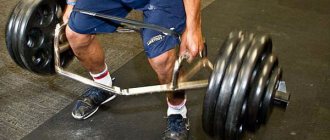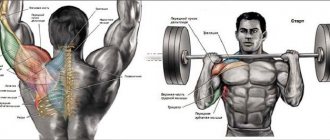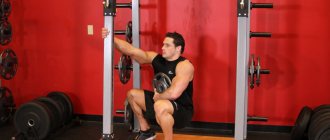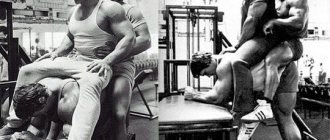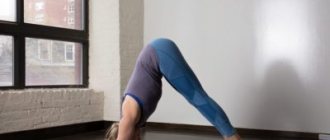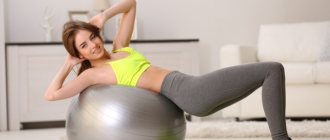Uttanasana translated means “stretched pose”; the spine in this asana is subjected to a uniform, intense stretch. There are several variations of the stretched pose: Pada Hastasana Uttanasana or forward bend helps relax the back muscles (yoga for the back is even better); Ardha Uttanasana helps to form correct posture, stimulates the muscles of the abs, lower back, legs and arms, increasing the overall endurance of the body; Hasta Uttanasana strengthens the muscles of the spinal region, relieving osteochondrosis, expands the chest and shoulders; Baddha Hasta Uttanasana relieves fatigue and allows you to calm down; Bandha Hasta Uttanasana increases the volume of the lungs, removes chronic tension in the neck-collar area and shoulders, and has a beneficial effect on the vascular system of the body.
Look what the equipment looks like in the photo.
Execution technique
Step 1:
Stand in Tadasana with your hands on your hips. Exhale and begin to lean forward, starting from the hip joints, not from the waist. As you bend over, simultaneously actively stretch the front of your torso directly from the groin area. Do not strain your back when bending.
When bending, try to lengthen your torso rather than twisting.
Aim to expand the space between your pubic bone and sternum.
Step 2:
Try not to bend your legs, pull your knees up.
When you have bent over as much as possible, place your palms or fingertips on the floor slightly in front or along the edges of your feet (palms parallel to your feet) or, if stretching allows, place your palms behind your heels or wrap them around your ankle joints. If this is not possible, cross your forearms and hold your elbows with your hands - let your arms hang under their own weight.
Press your heels firmly into the floor and pull your sit bones toward the ceiling. Turn the front of your thighs slightly inward.
Step 3:
Relax your neck. Let your head be in a free position and pull down under its own weight.
Step 4:
As you inhale, carefully raise your head, trying to look as high as possible. Straighten your arms and at the same time straighten your shoulders, arch your back, stretching your chest forward. The fingers should be fixed in the same position (fingers/palms on the floor, palms on the ankle joints). This position is also called Ardha Uttanasana.
As you exhale, drawing in your stomach (to make the fold deeper), move your body a little lower towards your legs - return to the starting position of the asana, fold.
Step 5:
Stay in the asana for 30 seconds to 1 minute. Uttanasana can be used as a resting asana between standing poses.
Uttanasana - Stretch Pose
We perform one of the main exercises for beginning practitioners - Intensive Stretch Pose, or bending forward with straight legs. It is important to take into account when performing this pose, which is simple at first glance, that it is performed with a straight back, which means that the body should be extended and pressed tightly to the legs. You should not ignore its development, because this asana often becomes key in a number of sequential poses and ligaments, such as Vinyasa and Surya Namaskar (Sun Salutation). In Sanskrit this pose is called “Uttanasana”. Sanskrit is incredibly beautiful, multifaceted and filled with deep meaning. The name of the pose is translated as follows: “ut” is a particle that means “balancedness,” “slowness,” “intensity”; The verb "tan" means "to lengthen", "to stretch out". In this asana, the spine is really stretched very intensely, provided it is performed correctly, of course.
The pose is not difficult to perform, but very often its implementation confuses beginners, as it turns out that immediately stretching the body along straight legs is quite difficult. Inexperienced practitioners pull their forehead towards their knees with all their might, the back is rounded, and as a result, a joyfully shining gap remains between the hips and stomach. The goal, on the contrary, is to press your stomach tightly against your thighs while performing this pose. And this turns out to be the cornerstone! The back just doesn’t want to straighten, and the stomach refuses to press against the hips. Why do we often encounter such difficulties in simple tilting? This is due to stiffened hip joints, shortened muscles of the back of the legs, which is very typical for a modern person who often leads a sedentary lifestyle, as well as frequent wearing of high-heeled shoes.
However, mastering this pose is very important as the practice of stretching has wonderful effects. Master Uttanasana, and its regular practice will help cure abdominal pain, normalize the menstrual cycle, and alleviate the pain symptoms associated with it. In addition, your liver, kidneys and spleen will receive beneficial effects. And, of course, intense traction will have a positive effect on the back muscles, and the spinal nerves will gradually become healthier. The heartbeat in this asana slows down, relaxes, and the entire nervous system is stabilized, which has a noticeable calming effect. Performing it for a long time (at least two minutes) is believed to help relieve depression, calm you down and return you to a calm and balanced state of mind. If you are a hot-tempered person, Stretch Pose is a godsend for you. Also in practice, it replaces the headstand (Shirshasana) for those who have not yet been able to master it.
When mastering this pose, it is important to understand the main principle: the tilt occurs not due to rounding at the waist, but due to rotation in the hip joints, i.e. the tilt should come from the joints.
Stretch pose: lightweight version
Often, it may not be possible to correctly assume the Stretch Pose in the very first classes, so first try to perform a lighter version.
- Exhale, bend over, gently bend your knees and lie with your stomach on your thighs, pressing them as tightly as possible. Grab your ankles from behind with your hands, inhale and, as you exhale, try to smoothly straighten your legs, continuing to press your stomach to your thighs as tightly as possible.
- Straightening your legs, reach your limit and try to breathe through the tension, directing your attention as you exhale to the place of maximum tension. And with each exhalation, try to straighten your legs more and more, work in the asana smoothly, without sudden movements in the flow of breath. With a little effort and regular practice, you will master this pose.
Uttanasana
Basic version of Stretch Pose
Once you have been able to fully straighten your legs and manage to remain in the Stretch Pose for more than 30 seconds, you can easily perform Uttanasana in the main version, that is, immediately going into a bend with straight legs.
- To do this, stand with a straight back, imagine how your axis runs from the top of your head through your tailbone to your very heels, build the Mountain Pose, inhale, place your hands on your hips or waist and lean back a little, literally bending slightly at the lower back.
- Next, with an exhalation, we bend forward, maintaining the lumbar deflection. The tilt should be done by rotating the hip joints, do not round the waist (if you keep your focus on a slight lumbar deflection, you will enter this pose with a straight, elongated back).
- Legs remain straight, feet pressed firmly to the floor, do not bend your knees, lower your palms to the floor in front of you. A more advanced option is when the palms, pressed tightly to the floor, are located on the sides of the feet. You can also place your hands on your ankles, clasping them from behind, and thus pull your stomach tightly towards your hips.
- We perform stretching in the flow of breath, with each inhalation we stretch the body along the legs, with each exhalation we press the stomach as close to the hips as possible and gradually position the entire body pressed tightly to the legs. We stretch our tailbone up. Breathing is even and calm. As we exhale, we direct our attention to the place of tension and try to relax it as much as possible.
- If it is still difficult to keep your legs straight and your body pressed against them, you can perform an elbow lock (clasp your elbows with your palms). Try to completely relax your body and neck. The head hangs freely. We continue to breathe smoothly, while exhaling and directing our attention to the area of the hip joints. And your body will gradually begin to sink lower and lower under its own weight. And then we try to lower our hands to the floor in front of us.
- The time spent in the Extension Pose is from 30 seconds to two minutes. After which we exit the asana smoothly, without jerking, resting our palms on our hips, and rise with an inhalation, directing our attention to the top of the head.
Uttanasana
Indications for performing the asana:
- osteochondrosis of the upper spine,
- upper respiratory tract diseases,
- kidney,
- menstrual irregularities,
- nervous fatigue,
- insomnia,
- fatigue,
- headache,
- eye fatigue.
Contraindications to intense stretching pose:
- all of the above diseases are in the acute stage,
- lower back and knee injuries,
- high and low pressure,
- disorders of cerebral blood supply,
- sciatica, pregnancy.
When hyperextending the knee joint, you should keep your knees slightly bent when bending over.
Benefit
- calms the brain and helps relieve stress and mild depression;
- reduces fatigue and anxiety;
- relieves headaches and insomnia;
- stimulates the liver and kidneys;
- stretches and strengthens thighs, calves, knees;
- improves digestion, relieves stomach pain;
- helps relieve menopausal symptoms;
- prescribed for the treatment of asthma, high blood pressure, infertility, osteoporosis and sinusitis.
Uttanasana for relaxation
Sometimes I use this pose to relax my back - it works great!
Just in the final position, do not grab your legs with your hands, but remain “hanging” with your arms lowered to the floor, or with your hands folded together, standing on your feet and leaning forward.
If you relax well, then after a while you will feel a pleasant “pain” in your back and as if even individual vertebrae, or rather, the ligaments between them, are being stretched.
As a rule, after 10-20 minutes of such relaxation, the back feels just great, but under no circumstances rise from this pose abruptly; Also, do not perform it if you have high blood pressure and other ailments listed below under the heading “Contraindications.”
Variations
- Light version
To increase the stretch in the back of your legs, bend your knees slightly. As you stretch your torso down, try to tuck your tailbone toward your pubis. As you exhale, grab your ankles or big toes with your hands. As you inhale, gently push the front of your thighs back and try to straighten your knees.
- Complicated version
A . Padangusthasana - bending over while grasping the big toe. After bending forward, grab your big toes with the index and middle fingers of each hand.
Then pull your fingers up and secure them with your thumbs. As you inhale, straighten your arms and lift the front of your torso away from your hips, arching your back as much as possible.
Hold the pose for a few breaths, then as you exhale, stretch forward and down, spreading your elbows to the sides.
B. _ Padahastasana (also described in the article Padangusthasana) - bending over with hands placed under the feet. This asana implies greater flexibility in the back and legs.
When performing this pose, the position of the hands is replaced (step No. 2) - that is, follow all the steps described above. The palms should be placed under the feet so that the big toes press on the wrist bones, and the index and middle fingers cover the feet from below near the heels.
Contraindications
The pose has some limitations:
- Since during the performance of this asana the main load falls on the spine, it is not recommended for use in cases of diseases/injuries of the spinal column and musculoskeletal system. In mild cases of pathologies, you need to practice under the guidance of an experienced yogi.
- People who have problems with blood pressure should take this position with caution, since a sharp drop in blood pressure may occur during the exercise. Patients with cerebral circulation disorders should not practice the pose.
- It is not recommended to practice yoga during infectious and viral diseases, at high temperatures and when feeling unwell. This asana is prohibited for pregnant women at any stage. People suffering from cancer can perform this asana only after consulting a doctor.
Uttanasana: counter-asanas
Before Padahastasana pose, it is best to perform Adho Mukha Svanasana, Janu Sirsasana, Paschimottanasana and Supta Padangusthasana poses.
After this, all standing poses, inverted yoga poses, or sitting forward bending poses are suitable.
Is Uttanasana effective for growth? In general, the growth of an organism depends on several processes other than stretching. However, in the case of children, practicing this pose under the guidance of a specialist will allow them to grow up with a healthy spine. And in the case of adults, regular practice of Padahastasana can straighten and restore the spine, which may also well affect a person’s growth.
General execution features
To bend forward more effectively, pull your stomach inward as you exhale and bend.
Breathing: exhale as you bend forward; reaching the final position, try to exhale as much as possible; in the final position, breathe normally; while inhaling, return to the starting position.
your attention to the pelvic area or to the Svadhisthana chakra.
To enhance the stretch, you can, in the final position, stand on your heels, raising your toes, and stretch your arms slightly forward along the floor, as if you were clinging to the floor in front of you.
You can also place your palms - with the inner side up - under your feet (This, in fact, will be Padahastasana).
In the final position, you can also place your hands on the floor further behind you, or grab the back of your heels - this will increase the stretch of your back.
